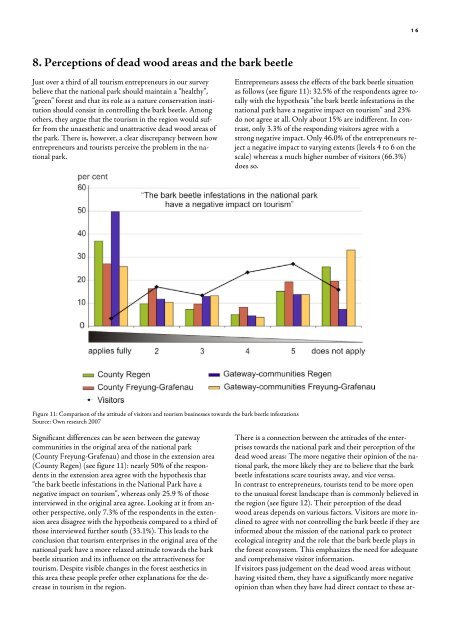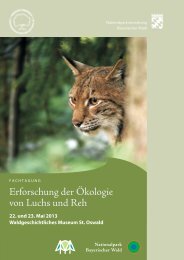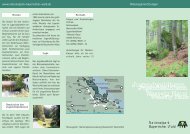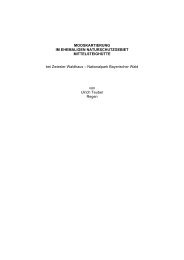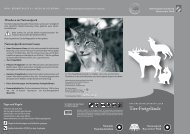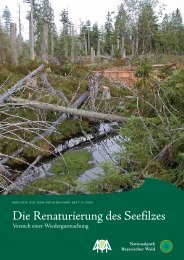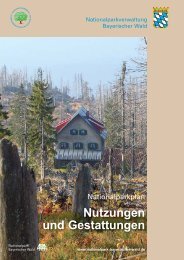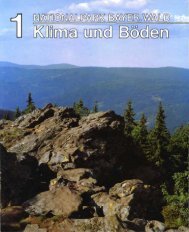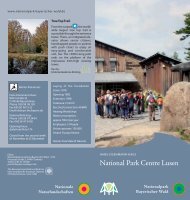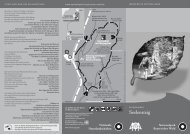The regional economic impact of Bavarian Forest National Park
The regional economic impact of Bavarian Forest National Park
The regional economic impact of Bavarian Forest National Park
You also want an ePaper? Increase the reach of your titles
YUMPU automatically turns print PDFs into web optimized ePapers that Google loves.
8. Perceptions <strong>of</strong> dead wood areas and the bark beetle<br />
Just over a third <strong>of</strong> all tourism entrepreneurs in our survey<br />
believe that the national park should maintain a “healthy”,<br />
“green” forest and that its role as a nature conservation institution<br />
should consist in controlling the bark beetle. Among<br />
others, they argue that the tourism in the region would suffer<br />
from the unaesthetic and unattractive dead wood areas <strong>of</strong><br />
the park. <strong>The</strong>re is, however, a clear discrepancy between how<br />
entrepreneurs and tourists perceive the problem in the national<br />
park.<br />
Figure 11: Comparison <strong>of</strong> the attitude <strong>of</strong> visitors and tourism businesses towards the bark beetle infestations<br />
Source: Own research 2007<br />
Significant differences can be seen between the gateway<br />
communities in the original area <strong>of</strong> the national park<br />
(County Freyung-Grafenau) and those in the extension area<br />
(County Regen) (see figure 11): nearly 50% <strong>of</strong> the respondents<br />
in the extension area agree with the hypothesis that<br />
“the bark beetle infestations in the <strong>National</strong> <strong>Park</strong> have a<br />
negative <strong>impact</strong> on tourism”, whereas only 25.9 % <strong>of</strong> those<br />
interviewed in the original area agree. Looking at it from another<br />
perspective, only 7.3% <strong>of</strong> the respondents in the extension<br />
area disagree with the hypothesis compared to a third <strong>of</strong><br />
those interviewed further south (33.1%). This leads to the<br />
conclusion that tourism enterprises in the original area <strong>of</strong> the<br />
national park have a more relaxed attitude towards the bark<br />
beetle situation and its influence on the attractiveness for<br />
tourism. Despite visible changes in the forest aesthetics in<br />
this area these people prefer other explanations for the decrease<br />
in tourism in the region.<br />
16<br />
Entrepreneurs assess the effects <strong>of</strong> the bark beetle situation<br />
as follows (see figure 11): 32.5% <strong>of</strong> the respondents agree totally<br />
with the hypothesis “the bark beetle infestations in the<br />
national park have a negative <strong>impact</strong> on tourism” and 23%<br />
do not agree at all. Only about 15% are indifferent. In contrast,<br />
only 3.3% <strong>of</strong> the responding visitors agree with a<br />
strong negative <strong>impact</strong>. Only 46.0% <strong>of</strong> the entrepreneurs reject<br />
a negative <strong>impact</strong> to varying extents (levels 4 to 6 on the<br />
scale) whereas a much higher number <strong>of</strong> visitors (66.3%)<br />
does so.<br />
<strong>The</strong>re is a connection between the attitudes <strong>of</strong> the enterprises<br />
towards the national park and their perception <strong>of</strong> the<br />
dead wood areas: <strong>The</strong> more negative their opinion <strong>of</strong> the national<br />
park, the more likely they are to believe that the bark<br />
beetle infestations scare tourists away, and vice versa.<br />
In contrast to entrepreneurs, tourists tend to be more open<br />
to the unusual forest landscape than is commonly believed in<br />
the region (see figure 12). <strong>The</strong>ir perception <strong>of</strong> the dead<br />
wood areas depends on various factors. Visitors are more inclined<br />
to agree with not controlling the bark beetle if they are<br />
informed about the mission <strong>of</strong> the national park to protect<br />
ecological integrity and the role that the bark beetle plays in<br />
the forest ecosystem. This emphasizes the need for adequate<br />
and comprehensive visitor information.<br />
If visitors pass judgement on the dead wood areas without<br />
having visited them, they have a significantly more negative<br />
opinion than when they have had direct contact to these ar-


